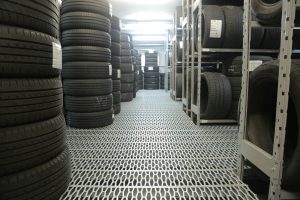Today, tyres are an essential part of every vehicle. They are sophisticated and designed for safety, performance and sustainability. However, the evolution of tyre technology is quite remarkable, and it was all inspired by a wheel which was invented more than 5,500 years ago.
Early Stages
In 1839, Charles Goodyear accidentally discovered vulcanisation – he dropped a mix of sulphur and rubber on a hot stove. The mixture of those two elements and heat caused the material to become more heat-resistant, elastic and stable. Vulcanisation is the process that made the commercial use of rubber possible.
Five years later, in 1845, Rober William Thomson began using rubber as a wheel-additive. He wrapped rubber tubes in a leather cover with the idea that tubes would help the wheel absorb the shock of the road when rotating.
Years later, in 1888, John Boyd Dunlop used Thomson’s design to create the first-ever practical tyre. Carl Benz invented the first-ever car in that same year and used Dunlop’s tyre for the car’s debut. In 1891, the Michelin brothers created the first detachable pneumatic tyre.
The first tyre designs did not feature any tread. They were thin and tall, similar to today’s bicycle tyres. In fact, it was not until 1905 that tread was added to the tyre, helping it handle wet and muddy road surfaces.
The Beginnings of a Modern Tyre
In the 1940s, Michelin invented the radial tyre, which can be considered a breakthrough in tyre technology. Radial tyres improved fuel efficiency, it had an improved lifespan, handling and comfort due to their reduced rolling resistance. It became the global standard for modern car tyres.
Synthetic rubber use started during WWII and it completely revolutionised the tyre industry. It provided greater control over tyre properties which helped create high-performance tyres with better grip, durability and fuel efficiency.
Later, during the 1960s, steel belts were introduced into tyres, which further improved their strength, performance and durability, especially for high-speed driving. Tread patterns were also further explored, aiming to improve traction and handling. The engineers came with new tread patterns for specific conditions: snow, off-road conditions, etc.
In the late 20th century, tyre manufacturers started focusing more on tyre performance. The 1990s saw the first silica-based compounds which improved fuel economy and wet grip. The computer-aided design (CAD) improved the design of the tread patterns which further maximised road contact. Run-flat tyre technology started gaining more attention during the 1990s. These tyres would not completely lose their function even after a puncture, which allows the short-distance driving to a service station, for example.
Environmental concerns started rising in the late 1990s and early 2000s and the tyre industry responded with various solutions that aim to reduce the environmental impact. Eco-friendly tyres started gaining more and more attention, as a key feature of the green revolution that improves sustainability while maintaining performance.
Tyre manufacturers started using more bio-based materials and introduced low rolling resistance tyres which provide improved fuel efficiency and reduced CO2 emissions.
The Future of Tyre Technology
The tyre development technology has come a long way since the discovery of rubber and vulcanisation. With years of innovation and development invested, we are now able to see some of the most advanced developments, such as the F1 tyres, which are made according to strict technical regulations, with every element designed from scratch. They have an optimum temperature range of around 90-110 degrees Celsius and the heat in general is what affects their performance the most.
Some manufacturers have worked and presented their ideas for airless tyres which run on unique structures and eliminate the risk of flat tyres completely. With the introduction of autonomous vehicles, tyre manufacturers have also started working on integrating sensors into tyres to provide real-time data, using Artificial Intelligence (AI) to help the vehicle make decisions about traction, tyre performance, etc.
However, the key focus of tyre development lies in sustainability and environmental impacts. The technology keeps evolving day by day and today’s tyres are optimised to improve fuel economy. Manufacturers have started focusing more on environmental impacts in manufacturing processes and tyre retreading and recycling are the main trends of the current tyre industry.
The significance that tyres have on overall driving safety should not be foreseen. Make sure to always check your tyres and choose wisely when opting for new ones!
From Invention to Innovation: The Evolution of Tyre Technology
From Goodyear’s vulcanisation discovery to AI-enabled and eco-friendly tyres, the tyre industry has evolved dramatically to meet modern demands for safety, performance, and sustainability. As tyre technology continues to advance, choosing the right tyre is more important than ever. Explore quality, innovation, and trusted brands at tayaria.com—your destination for reliable tyres in Malaysia.





